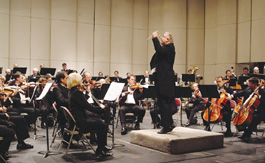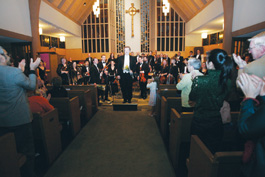home | metro silicon valley index | music & nightlife | preview

Measure for measure: Maestro Mitchell Sardou Klein leads the Peninsula Symphony.
Orchestra Whirl
Symphony Silicon Valley is just the tip of the musical iceberg; the South Bay is host to a dozen more flourishing symphonies
By Scott MacClelland
EVERY TWO or three years, the major media decide to remind us how desperate the state of classical music is in America. They start either with statistics about how classical CD sales are in the toilet or the bad news of a just-reported insolvency by another major symphony orchestra. But if things are all that bad, how come Symphony Silicon Valley—after five years still one of the newest orchestras in the country—is doing so well? Then, answer this puzzler: Why does Silicon Valley and environs sustain at least 13 orchestras in addition to the big dog, Symphony Silicon Valley (not to mention many youth symphonies and ensembles)? Between Redwood City and Gilroy, a casual search will turn up a variety of orchestras, amateur and professional, large and small, some that have been around for decades, many that host world-class soloists, some that make CDs of their concerts, a few that introduce new works they've commissioned and each with a music director who comes with credentials and/or experience.
Most of the orchestras in this list have season-ending concerts scheduled in the next few weeks (including Symphony Silicon Valley, which performs May 10-13 with guest conductor Joseph Silverstein and violinist Avel Strauss and Cellist Mark Kosower).
Oldest by far is the Stanford Symphony Orchestra, founded in 1891 and now conducted by Beijing-born Jindong Cai, who enjoys international stature for his appearances in this country and abroad, including his native China. The orchestra of some 90 advanced students plays its next concert, "Made at Stanford—Max Mathews Eightieth Birthday Celebration," on April 26, 8pm, at Dinkelspiel. The Spring Quarter Concert, May 19, 8pm, also at Dinkelspiel, encompasses works by Brahms, Delius, William Kraft and Stanford composer Jonathan Berger. (650.723.4304; stanford.edu/group/sso/)
Aaron Sten served as founding music director of the Peninsula Symphony, conducted for the past 22 years by Mitchell Sardou Klein, who has spent a lifetime in professional music. The orchestra performs at Flint Center, San Mateo Performing Arts Center, Redwood City's Fox Theatre and other venues. The musicians, who enjoy average concert attendance between 1,200 and 1,500, are both professional and amateur, all with extensive experience.
The budget has grown to $550,000, to accommodate the orchestra's generous season—September to July—and includes in-school programs, competitions, family concerts, adult education and free pops. For his subscription programs, Klein favors long programs, bucking the now common trend for shorter ones, plus high-profile soloists and rare and unusual programming.
At its next program, May 18-19, Christopher O'Riley plays Schumann's Piano Concerto and Alison Luedecke takes the console for Saint-Sëns' Organ Symphony. (650.941.5291; www.peninsulasym.org) Nova Vista Symphony was founded in 1966 by conductor John Mortarotti. Ann Krinitsky, its sixth music director, has held the position since 2006. The orchestra plays four subscription concerts between October and May at Foothill College's Smithwick Theatre and has just started to present programs at Mountain View Center for Performing Arts. Krinitsky, whose association with Nova Vista goes back five years, says, "While many professional orchestras in this country are struggling, community orchestras continue to thrive." Equally important to Krinitsky is the education of her players through the introduction of new repertoire, a process that is no less valuable to her. (408.530.0700; www.novavista.org)
Often, community orchestras start as class offerings at schools that require enrollment, minimal attendance and tuition and sometimes offer college credit. The South Valley Symphony began modestly as a Morgan Hill school program, founded in 1972 by violinist Kathleen Ash-Barraclough, who served as music director until 1990, by which time the orchestra, now independent, had affiliated with Gavilan College in Gilroy. Jason Klein replaced Ash-Barraclough at the helm and was in turn replaced in 1999 by Henry Mollicone. Anthony Quartuccio has applied his substantial experience to the post since 2005. The SVS draws on amateur musicians from four counties and performs four subscription programs per season at Gavilan College Theater, with run-outs to Mission San Juan Bautista. The symphony finishes its season May 13, 4pm, at the Mission with Copland's Fanfare for the Common Man and Beethoven's Symphony no. 5. (408.846.1441; www.southvalleysymphony.org)
Like many of his conducting colleagues, Eric Kujawsky has applied a substantial music education to a passionate avocation. In 1985, Kujawsky founded the Redwood Symphony as a community orchestra affiliated with Cañada College, and he has served ever since as its music director. (By day, he is a high school teacher.) He says, "I wanted to create an orchestra that would be different from all the other ones, bypass the traditional route, start with the stuff I really wanted to do," and, he adds cheekily, "to create a stir and get some attention."
After a few years, the college discontinued offering the orchestra as a class, forcing Kujawsky to move venue to San Mateo's Bayside Performing Arts Center. But next year, the orchestra will return to Cañada's Main Theatre. Between October and June, the RS offers five subscription programs plus a family concert and summer pops. Kujawsky attracts the "best possible" volunteer musicians by offering rare and sometimes extremely challenging repertoire, like the Mahler symphonies and major works by Stravinsky and Bartók. The June 10, 3pm, program will include Copland's Third Symphony; Messiaen's sprawling Turangalila is on tap for the future. CDs are commercially available through Amazon and the orchestra's website. (650.366.6872; www.redwoodsymphony.org)
The Palo Alto Philharmonic emerged in 1988 from a split within the erstwhile Palo Alto Symphony, with Gideon Grau as music director through 2003, Ann Krinitsky 2005-06 and Thomas Shoebotham since then. The PAP gives one (usually) performance of four subscription programs plus a youth/family concert—upcoming on May 20, 3pm—at Cubberley Theatre in Palo Alto, with occasional run-outs to other venues. Programming tends toward the traditional, attracting a generally conservative audience. (A highlight of the current season was Bartók's Third Piano Concerto, featuring the internationally acclaimed Jenö Jandó.) Shoebotham's credentials include two masters of music degrees and affiliations with the Peninsula Symphony, Berkeley Opera and Opera San José. The PAP has introduced new works by composer-in-residence Lee Actor, John Biggs and others. (www.paphil.org)

Crowd pleaser: Michael Paul Gibson and the Silicon Valley Symphony reap their rewards at the end of the orchestra's recent 'Poulenc 'n' Pipes" concert in Los Gatos.
Barbara Day Turner's fully professional, all-string San Jose Chamber Orchestra has enjoyed a winning formula since its founding in 1991. Programming favors the rare and unfamiliar by well-known composers, and no small number of audience-friendly new works, including commissions and premieres. Soloists, sometimes including chamber choir, are a mainstay, and San Jose's intimate Le Petit Trianon concert hall offers some of the liveliest and most vivid acoustics in the region. Guest artists include conductors, but Turner's high-energy leadership at all levels explains the orchestra's enthusiastic following, $225,000 budget and six-concert subscription season. Accomplished student musicians are regularly featured, including the SJCO's two youth orchestras. The orchestra welcomes guest harpist Dan Levitan on May 20, 7pm, to perform Craig Bohmler's Concerto for Harp. (408.295.4416; www.sjco.org)
Symphonic bands didn't exist until the early 20th century, and then with thanks largely to British composers, notably Gustav Holst and Australia-born Percy Grainger. American composers caught on quickly and began to enrich a repertoire of original works and arrangements of orchestral music that today is wholly international. The San Jose Wind Symphony grew out of the music program at San Jose City College in 1958, following the vision of Darrell Johnston; Edward Harris now serves as the music director. The list of its guest artists gives testimony to its rarity and quality. On May 20, 3pm, the band performs at Saratoga's McAfee Auditorium and hosts guest clarinetist Janet Averett in a program that includes Holst's A Somerset Rhapsody, Liszt's Hungarian Rhapsody and Debussy's Premiere Rhapsody—hence the title "Rhapsodies From Around the World." (408.927.7597; www.sjws.org)
While Herb Gellis founded the Hewlett Packard Symphony Orchestra in 1993, and remains its music director in charge of an idiosyncratic repertoire, George Yefchak is its principal conductor. Having grown out of the HP corporate community, the orchestra continues to perform at the company's Cupertino campus, with concerts at San Jose's Foothill Presbyterian Church, but now with more community participation. Its two seasons, spring and fall, include between three and five concerts, with a programming mix that includes concertos and guest soloists. For May, the orchestra offers a "Friends and Family" concert, May 11, 6:30pm, at HP in Cupertino, and May 18, 7pm, at Foothill Presbyterian Church in San Jose. (www.hpsymphony.org)
Music director Emily Ray created the Mission Chamber Orchestra in 1996 and calls San Jose's Le Petit Trianon home. The orchestra has also performed at St. Joseph Cathedral, San Jose City Hall Rotunda, Sun Microsystems Auditorium and Mission College. Professional soloists and unique programming, including commissions by local composers, are touted in four subscription programs between October and April, plus additional performances in service to local choirs. (Last season, it joined the San Jose Symphonic Choir for the premiere of Henry Mollicone's Beatitude Mass.) The MCO sustains two outreach programs with area high schools including one-on-one participation in concerts. Jon Nakamatsu joins them for Beethoven's first piano concerto on April 28. (408.236.3350; www.missionchamber.org)
Jason Klein was asked to assume control over the shaky Palo Alto Symphony in the late '80s, relocated it to West Valley College in 1996 and retitled it Saratoga Symphony. Klein, who is something of a maverick, operates without an official board of directors or fundraising guild and sells no tickets, instead depending on donations and outside gigs for funding. In exchange, he tempts accomplished amateur musicians with obscure romantic works by such as Gade, Raff, Glazunov, Chadwick, MacDowell and Zeisl. He has also included new works by Lee Actor, among others. On May 6, 3pm, at St. Andrews Episcopal Church in Saratoga, the program features two works each by Glazunov and Saint-Saëns. (www.saratogasymphony.com)
Following a change of administration in 2000, Santa Clara University's student orchestra was shown the door. Its conductor, Henry Mollicone, decided in favor of the musicians—"They love making music," he says—and renamed it Winchester Orchestra. As an independent community orchestra, Winchester gives two performances of four programs each season at West Valley College Theater and Trinity Cathedral in San Jose. Soloists are drawn from among area musicians and include, at least once a year, an accomplished student. This season's finale is set for May 18 (7:30pm, Trinity) and May 20 (7pm, West Valley), and opens with one of Mollicone's own sparkling symphonic works. (408.269.1905; www.geocities.com/winchesterorchestra)
The newest kid in town is Silicon Valley Symphony, founded in 2001 by Michael Paul Gibson, music director at Presbyterian Church of Los Gatos, who claims 36 years of orchestral conducting and bluntly declares, "My passion is conducting orchestral music." He also lays claim to the name of his orchestra "a couple of years before the Symphony Silicon Valley came into existence." (Andrew Bales, of SSV, says his organization did a national name search that turned up nothing, only hearing of Gibson's orchestra after SSV had incorporated.)
SVS's three regular concerts per season—recorded on CDs for participants and friends—are played at Los Gatos Presbyterian. Like most community orchestra conductors, Gibson finds himself competing for key players. He says, "We give exceptional musicians who do not need to make their living playing in the SVS the opportunity to perform the great standard repertoire and many new compositions." SVS's May 19, 8pm, program will include the premiere of Lee Actor's new horn concerto. (www.bamusic.org/svs)
Send a letter to the editor about this story.
|
|
|
|
|
|